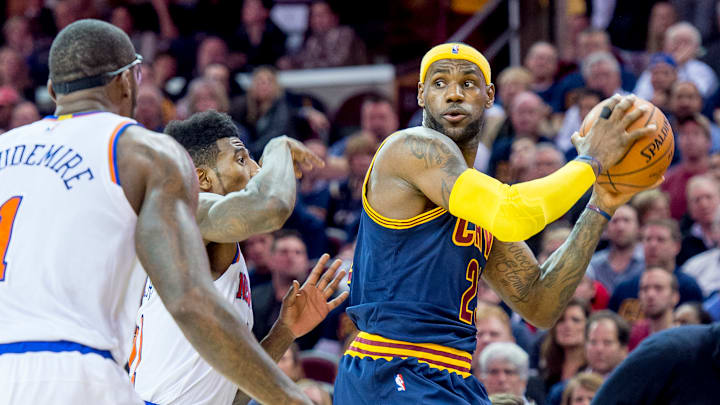When the Cleveland Cavaliers drafted LeBron James first overall in the 2003 NBA Draft, their path forward became obvious - build a contender around a homegrown superstar.
James wasted no time before impacting winning with the Cavs. In the 2002-03 season, Cleveland ended with a dismal 17-65 record. The franchise had intentionally tanked for James, trading away Andre Miller to force themselves to the bottom of the standings. Because of that, LeBron's Cavaliers started from square one. He was the foundation and crux. James led Cleveland to a 35-47 record in his rookie season, averaging 20.9 points, 5.9 assists and 5.5 rebounds per game.
Because of James' immediate value, Cleveland launched from the bottom of the Eastern Conference to the playoffs. This kept the Cavaliers from building a greater core around James through the Draft. Cleveland's routes to contention were suddenly limited without an established foundation around him.
The Cavaliers turned to the trade market to no avail. Cleveland secured All-Stars past their prime but could not find the right running mate for James. As LeBron continued to carry the Cavaliers far into the postseason, including a 2007 Finals appearance, Cleveland could not capitalize on the special talent.
James made the Cavaliers too good to fail enough to succeed, but the franchise's quest to draft him left them with a shallow roster and few trade pieces. Countless trade offers fell apart, but the Cavaliers' final effort may be the greatest "what if" move in the first James era.
The one that got away
In early 2010, the Cavaliers targeted one final attempt to add a true second star to the roster as James approached unrestricted free agency. If Cleveland stayed silent on the trade market, they could waste the final season of LeBron in the wine and gold. As the deadline approached, Cleveland was negotiating a deal to bring a three-time All-Star big man to town.
With a package surrounding Zydrunas Ilgauskas and J.J. Hickson, the Cavs were prepared to bring Amar'e Stoudemire to the Land as James' co-star in an all-in move toward the 2010 Finals. Cleveland was chasing after the 2009 NBA East Champions Orlando Magic with Dwight Howard. Adding a star-level center was meant to give the Cavs the firepower in the post to overcome Orlando's own stardom.
In Stoudemire's prior season, the Phoenix Sun legend averaged 21.4 points, 8.1 rebounds and 1.1 blocks alongside Hall of Fame point guard Steve Nash. Stoudemire was not just a star player. He was a pillar for one of the greats eras of Phoenix basketball, helping establish the famed "seven seconds or less" Suns offense.
A dynamic and athletic point forward like LeBron seemed like the perfect partner for Stoudemire to join. James was a transcendental player in a mismanaged franchise. The Suns were in a position to move Stoudemire, too, given that Amar'e was also headed for free agency. With constant failed playoff runs, Phoenix faced the possibility that Stoudemire left for nothing just like Cleveland.
Unfortunately, the Suns vetoed the deal. Stoudemire stayed in Arizona and James Ohio. The Cavs pivoted to Antawn Jamison, a two-time All-Star veteran. A force to be reckoned with in his own right, Jamison was a reasonable pivot. Still, the Cavaliers fell short of the ultimate goal once again as Jamison did not fit with the Cavs as much as the franchise hoped.
One failure, two franchises destroyed
In the end, both the Cavaliers and Suns endured the worst possible outcome. The Suns seemingly preferred re-signing Stoudemire over the Cavs' offer, but Amar'e left that summer to join Carmelo Anthony in the Big Apple New York Knicks. James, Akron's own, departed for the Miami Heat to form the now-historic Miami Heatles with Dwyane Wade and Chris Bosh.
Both Cleveland Phoenix plummeted in the standings, rejoining the lottery-bound organizations just one year after trips to their respective Conference Finals. The Cavaliers were unwilling to sweeten the pot enough to convince the Suns out of fear that James would leave anyway. As for the Suns, dealing their All-Star forward rather than hoping he would stay led them to veto the move.
Stoudemire and Anthony were a dominant duo in New York, although they could never achieve what Stoudemire and Nash failed to do. As for James and the Heat, Miami added four Finals appearances and two rings. James finished his four-year stint with the Heat with an overall 215-79 win-loss record. He was undoubtedly the greatest free agent to join the franchise in history.
The Suns eventually entered a full rebuild, watching Nash join the Los Angeles Lakers and resetting for the future. On the other hand, readers know the rest of the story for the Cavaliers. James returned to fill his promise, delivering the unforgettable 2016 Finals Championship to end the 52-year draught for the city.
While the Cleveland Cavaliers received the desired ending to the story, the path to achieving a championship with LeBron James was anything but ordinary.
